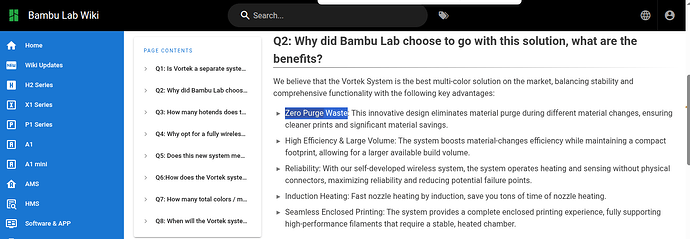Printer cuts filament 1, parks nozzle 1 and retracts filament 1 from the toolhead.
Takes nozzle 2, loads filament 2 and prints.
Then cuts filament 2, parks nozzle 2 and retracts filament 2.
Loads filament and nozzle 1 and prints. No need to poop if reusing each nozzle with its original filament.
IIRC, Bambu promised zero-poop, not zero-purge/zero-waste.
Right. Still priming, rather than purging.
I presume there will be a bit of retraction before the cut is done, Hopefully by the time priming has finished the cut will be far enough into the melt zone to fuse back together again.
While a disconnect between the old and new filament may seem like an issue remember that retraction is done to remove the pressure the filament in the melt zone has on it. It doesn’t actually need to remove the filament from the melt zone, only give it space to allow it expand upward instead of staying in compression and as a result it is forced out the nozzle orifice.
Exactly, there is a difference between purging and priming. I’m pretty sure all the multi head systems (XL/U1) currently still need a prime/wipe tower on the bed.
If you’ve used the auto refill via AMS, the extruder will quickly purge some filaments. I think this is to even out any flow inconsistencies from what is essentially two piece of broken filaments in the ‘connecting’ spot.
Technically it’s still ‘zero purge’ if Vortek just ‘purges’ this same amount on to the prime tower ![]() , but we’ll see.
, but we’ll see.
Sorry, I used the wrong wording. What I should have written is that Bambu never promised a zero-prime system, not a zero-poop/zero-purge/zero-waste system.
Indeed, they highlight that they ensure significant material savings, but are not promising zero-waste, zero-prime.
Well spotted ![]()
They resist making a real tool changer I believe due to selling AM$ units and I am predicting that the H2C will have an advantage if using AM$ HT units to quicker load filament and have it parked nearby. It would prompt buyers to purchase more units for quicker loading.
That’s where the “long retract before cut” feature comes into play. That and the new filament will fuse with the old stuff in the large melt zone
cant really agree with that. A said real tool changer means huge pain in both space and filament and filament path management. Basically removing it from the hobbiest market. AMS while we hate many things about it, it’s a better design for most filaments other than TPU or PPACF. And also, a real tool changer would still suffer from PPA-CF or brittle filaments. They can only do a bit better at TPU.
If the said design is optimal, you should see it much more popular in DIY world or from competitors. But instead the market prefers AMS/CFS/ACE… a lot more than “a real tool changer”. Which comes to the question of, you want a printer that can print lots of different TPU, but with a lot of pains; or you want a printer that can print lots of different filaments except TPU (but you can still print TPU in one color), and save lots of hussle. I mean the choice is pretty clear right…
Thats an interesting thought. They have shown some willingness to work with other manufacturers like E3D for their P1/X1 HF nozzles. But they also prefer to develop their own products like the H2 HF nozzles. We dont know what is going on behind the scenes and if they licensed the tech from E3D/3D Solex or developed their own. I am not sure if they would work with Bontech for their INDX or would develop their own solution since its a core technology for their business, unlike the nozzles.
Can’t see the new nozzles being more than current X1C complete hotend cost wise as that has more components, X1 is arguably more complex to assembly/manufacture and difficult to automate that build. BL will want to auto assembly for accuracy and that’ll get cost down. $35 per nozzle would be my guess but wouldn’t be surprised if its under that.
Induction both for heating and data isn’t complex, they don’t need data huge bandwidth either. The heating side is just an induction ‘receiver’ as the tool head has those big C shaped wedges either side of the nozzle for the ‘transmit’ side.
